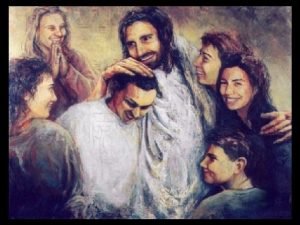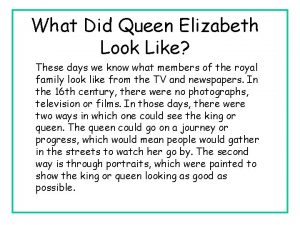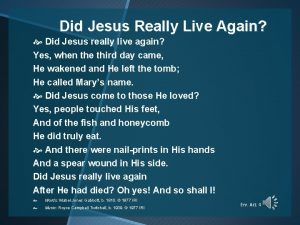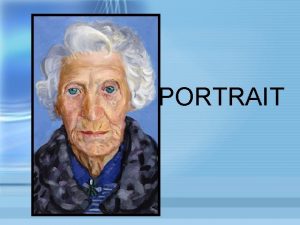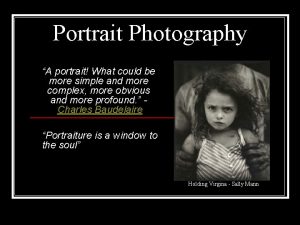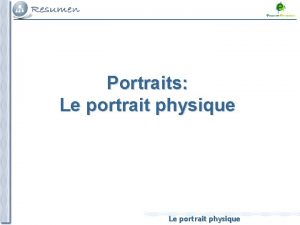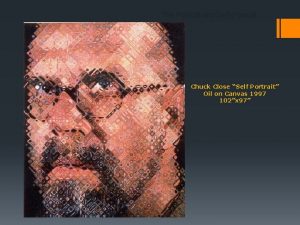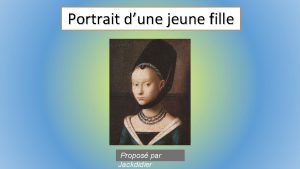The Portrait of Jesus What Did He Really












































- Slides: 44


The Portrait of Jesus What Did He Really Look Like?




The Real Face of Jesus Dec. 2002 Mike Fillon “Does not even nature itself teach you that if a man has long hair, it is a dishonor to him” (1 Cor 11: 14). “Most biblical scholars believe that it was probably short with tight curls. ” - Mike Fillon



The Shroud of Turin • Some believe this is the true shroud that Joseph of Arimathea placed over the face of Jesus at His death (Mt. 27: 59; Mk. 15: 46). • The Shroud of Turin comes to life in historical documents starting the 14 th Century (1300’s). Why? • Carbon dating done in 1988 gives a date of the shroud only back to the Middle Ages.

The Early Christians Rejected the Desire to Portray Jesus Physically The First 300 • Years Not Only Did They Refuse to Make a Portrait of Him, They Would Not Describe His Physical Appearance Like They Did For John the Baptizer. “The writers of the New Testament were interested in what Jesus said and did rather than in how he looked” - Roland Bainton, . Behold the Christ. Page 13

The Early Christians Rejected the Desire to Portray Jesus Physically “Early Christians did not make physical portraits of Jesus because one, they did not want to know Him in the flesh, but in the spirit. ” - Gabriele Finaldi. The Image of Christ. Pg. 9

The Church Fathers • • Irenaeus (d. c. 202), Clement of Alexandria (d. 215), Lactantius (ca. 240 – ca. 320) Eusebius of Caesarea (d. ca. 339) Disapproved of physical images of Jesus.

The Church Fathers “God alone is to be feared, He who is not visible to human eyes, nor comes within the compass of human art. ” - Tatian the Assyrian (2 nd Century) Ante-Nicene Fathers, Volume 2, PC Study Bible formatted electronic database Copyright © 2003, 2006 by Biblesoft.

A 2 nd Reason “You shall not make for yourself an idol, or any likeness of what is in heaven above or on the earth beneath or in the water under the earth. You shall not worship them or serve them; for I, the Lord your God, am a jealous God…” (Ex 20: 4 -5).

Early Legends and Myths Developed As to His Appearance Eusebius Writes of a Statue of Jesus With the Hemorrhaging Woman. “An elevated stone, by the gates of her house, a brazen image of a woman kneeling, with her hands stretched out…Opposite this is another upright image of a man…clothed decently in a double cloak, and extending his hand toward the woman…They say that this statue is an image of Jesus. It has remained to our day, so that we ourselves also saw it when we were staying in the city. ” Nicene and Post-Nicene Fathers, Series 2, Volume 1, Book 7, Ch. 18

Early Legends of His Appearance Being Made “One legend claimed that Abgar, the king of Edessa, had sent a messenger to Jesus who returned with a portrait. ” “According to another legend, the evangelist Luke was alleged to have been the first to paint the Virgin Mary and the babe. ” - Bainton, 14




The First Portraits of Jesus Came in the Form of Signs and Symbols • Christian Symbols Were Used to Decorate the Sepulchers of Christians, Especially in the Catacombs of Rome.


Funerary slab of Aurelius Castus 3 rd or 4 th Century Rome Funerary slab of Florentius 4 th Century Rome

The Good Shepherd Sculpture 3 rd or 4 th Century 3 rd-century fresco from the Catacomb of Callixtus

Oldest Portraits of Jesus This painting is on the wall of the baptistery of a church in a (long abandoned) ancient city in Syria. It depicts the story of the healing of the paralytic found in Mark 2, and it is dated to the mid-3 rd century (A. D. 235).



Oldest Portraits of Jesus “The Good Shepherd” image is found in the St. Callisto catacomb in Rome and is believed to have been painted around the 3 rd century.


Catacomb of Domitilla, early fourth century. Christ Among His Apostles

Oldest Portraits of Jesus This appears in a cemetery in an imperial villa that belonged to Constantine and is dated to the 4 th century. Christ Between Peter and Paul



Oldest Portraits of Jesus This is the oldest surviving panel icon of Jesus, and it is found at Saint Catherine’s Monastery on Mount Sinai. Painted in the 6 th Century. Christ Pantokrator – Lord of Hosts

Where Did the Traditional Portrait of Jesus Come From? • The most significant factor in the traditional portrait of Jesus is the influence of paganism and philosophy in the lives of new converts. • Much of the early religious art had traces of pagan imagery. “As Christianity gained converts, these new Christians had been brought up on the value of images in their previous cultural experience and they wanted to continue this in their Christian experience” (Dr. Allen Farber. Early Christian Art. Website: The Khan Academy).

“Except for differences in subject matter, Christian and pagan works looked much the same; in fact, it is possible to show that the same workshop sometimes produced sculpture for both Christian and non-Christian purposes” Encyclopedia Britannica. Early Christian Art. Written by the Editors.

“Early Christians decorated their catacombs with frescoes, or paintings on fresh plaster. These frescoes are very simple and allegorical; not refined at all. This sort of primitive Christian painting copies the Pompeian style that was popular across the Roman Empire. They just reused an old style for new content” Max Pfingsten. Early Christian Art: History, Characteristics & Symbolism. Website: Study. com. Chapter 6, Lesson 14.

“The earliest images of Christ are inconsistent. Some show him as a beardless shepherd boy, carrying a lamb on his shoulders. Others depitct him as a variant of the pagan father gods, Zeus and Serapis. It was this second tradition that prevailed” Edward Lucie-Smith, . The Face of Jesus. Abrams: New York. 2011. Pg. 14. The god Serapis

Jupiter King of the gods

Neptune god of the Sea

Pluto god of Death and the Underworld

There Is One Passage That Describes Jesus’ Appearance Isa 53: 2 -3 “For He grew up before Him like a tender shoot, And like a root out of parched ground; He has no stately form or majesty That we should look upon Him, Nor appearance that we should be attracted to Him. He was despised and forsaken of men, A man of sorrows, and acquainted with grief; And like one from whom men hide their face, He was despised, and we did not esteem Him. ”



 Jesus is the sweetest name i know
Jesus is the sweetest name i know Jesus in the morning jesus in the noon time
Jesus in the morning jesus in the noon time Jesus beard
Jesus beard What did elizabeth i really look like
What did elizabeth i really look like Did maximus really exist
Did maximus really exist Oldest photo of jesus
Oldest photo of jesus Jesus you are lord
Jesus you are lord Se um hino cantar tu puderes
Se um hino cantar tu puderes Jesus jesus how i trust him
Jesus jesus how i trust him Lebrnslauf
Lebrnslauf Hát kết hợp bộ gõ cơ thể
Hát kết hợp bộ gõ cơ thể Lp html
Lp html Bổ thể
Bổ thể Tỉ lệ cơ thể trẻ em
Tỉ lệ cơ thể trẻ em Voi kéo gỗ như thế nào
Voi kéo gỗ như thế nào Tư thế worm breton là gì
Tư thế worm breton là gì Bài hát chúa yêu trần thế alleluia
Bài hát chúa yêu trần thế alleluia Các môn thể thao bắt đầu bằng tiếng chạy
Các môn thể thao bắt đầu bằng tiếng chạy Thế nào là hệ số cao nhất
Thế nào là hệ số cao nhất Các châu lục và đại dương trên thế giới
Các châu lục và đại dương trên thế giới Công của trọng lực
Công của trọng lực Trời xanh đây là của chúng ta thể thơ
Trời xanh đây là của chúng ta thể thơ Cách giải mật thư tọa độ
Cách giải mật thư tọa độ 101012 bằng
101012 bằng độ dài liên kết
độ dài liên kết Các châu lục và đại dương trên thế giới
Các châu lục và đại dương trên thế giới Thể thơ truyền thống
Thể thơ truyền thống Quá trình desamine hóa có thể tạo ra
Quá trình desamine hóa có thể tạo ra Một số thể thơ truyền thống
Một số thể thơ truyền thống Bàn tay mà dây bẩn
Bàn tay mà dây bẩn Vẽ hình chiếu vuông góc của vật thể sau
Vẽ hình chiếu vuông góc của vật thể sau Thế nào là sự mỏi cơ
Thế nào là sự mỏi cơ đặc điểm cơ thể của người tối cổ
đặc điểm cơ thể của người tối cổ V cc cc
V cc cc Vẽ hình chiếu đứng bằng cạnh của vật thể
Vẽ hình chiếu đứng bằng cạnh của vật thể Vẽ hình chiếu vuông góc của vật thể sau
Vẽ hình chiếu vuông góc của vật thể sau Thẻ vin
Thẻ vin đại từ thay thế
đại từ thay thế điện thế nghỉ
điện thế nghỉ Tư thế ngồi viết
Tư thế ngồi viết Diễn thế sinh thái là
Diễn thế sinh thái là Dạng đột biến một nhiễm là
Dạng đột biến một nhiễm là Các số nguyên tố là gì
Các số nguyên tố là gì Tư thế ngồi viết
Tư thế ngồi viết Lời thề hippocrates
Lời thề hippocrates


